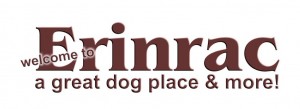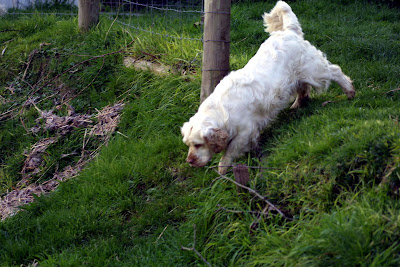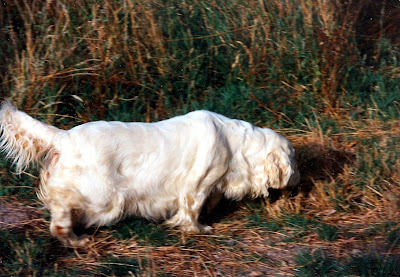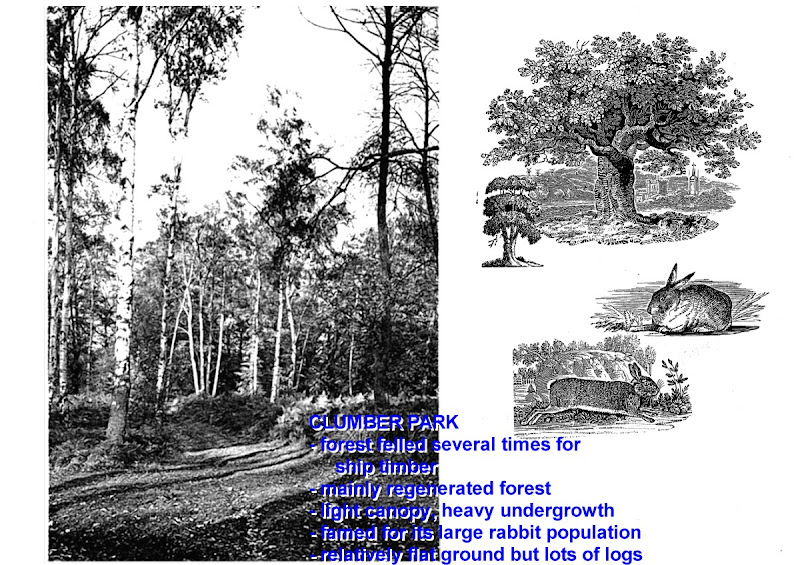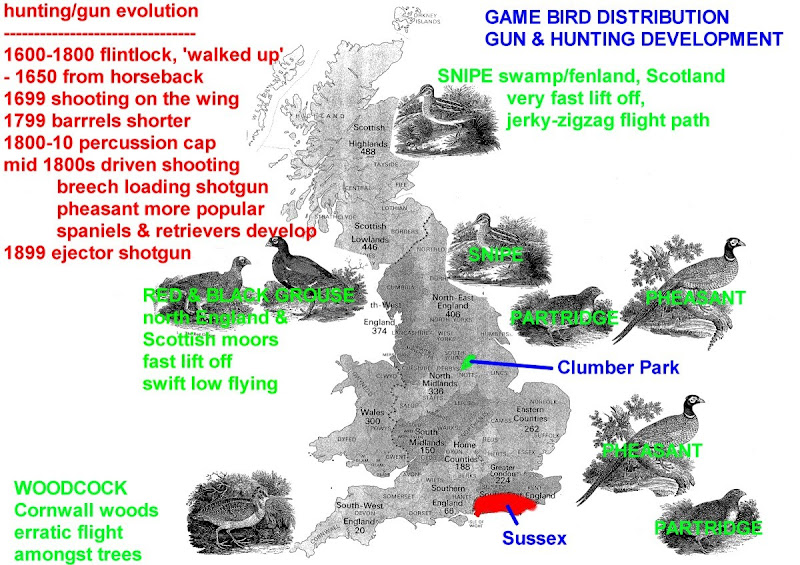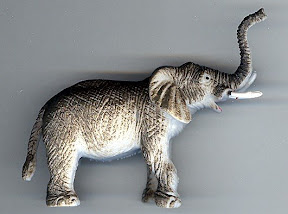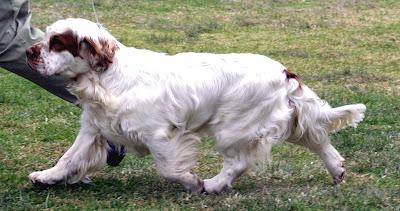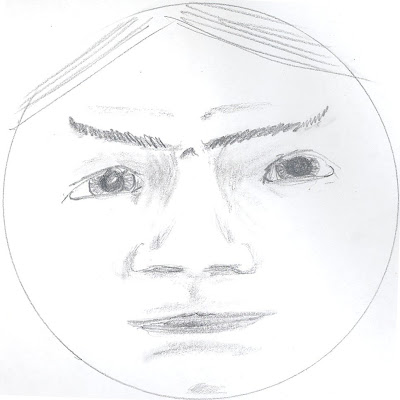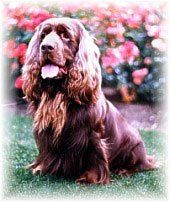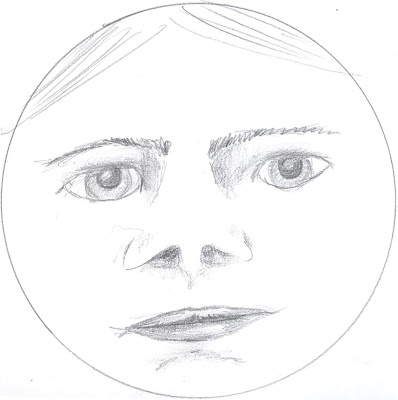Welcome
I have been asked to present the breed lectures for the Clumber and Sussex Spaniels – this is not just a lecture or a review of the breed standards as adopted in Australia, but (I hope!) a learning experience for all.
The material and resources will be available online for later reference.
Now this is not a passive learning exercise – everyone please stand up – those who have read their standards this month, please take one step back.
These two breeds are often lumped together – like tonight; but if you can tell the difference
- between brie and cheddar
- between forest and grassland
- between roses and daisies
you can easily discern a Sussex from a Clumber. You may not find it easy to start with (could you tell the difference between a book and a magazine when you were a toddler?) but with some thought and observation on your part (your part, not my lecturing) you will.
And I plan to guide you a step further. You are going to be able to quickly identify good and bad type within both breeds – if you do a bit of homework you can take that a step further and impress everyone, you will be able to say why one or another is a good Clumber or a good Sussex – and you won’t have to memorize word for word any one breed standard or (like some trainee judges a few years back) the call names of the said good and bad dogs!
I am fairly familiar with the breed standard for the Clumber, I actually used it in my consideration for which dog is mated to which bitch, where to look for new imports, and occasionally have to discuss it. The Sussex standard I rarely look at, despite more than a passing interest in the breed, so (as I suspect there are quite a few, in this room, who haven’t read it recently) let me list some points that STRUCK me.
“Free” shoulder – wow, interesting, I bet that isn’t quite like a free or floating rib or there would be lots of trips to the vet or chiropractor; the converse (in my mind) would be a tied shoulder, then again not even with my background in horses and horse conformation is “tied shoulder” a term commonly used, but perhaps it can be likened to or made parallel with “tied at elbow”
“Knees” on the forelimbs, very interesting to see a horsey common label still tucked away in a dog standard, OK everyone, you tell me … the front “knee” is more commonly called a
….. “wrist” (that’s ANKC Terminology)
Endear themselves, but in the field (ie when hunting)
- they are required to ‘find’ game,
- flush that game so the gun (hunter) can shoot or otherwise capture the meal,
- and a useful one will bring the dead game to the hunter, but retrieving is not an essential ability for the spaniel.
To find game, the dog needs to be
- fit
- sound
- alert
- able to deduce and detect game
- advance upon that game without scaring or flushing it until reasonably close (which assumes the gun is reasonably close to so he can get a good shot in)
The English Springer, Welsh Springer and Field Spaniels tend to be the great all rounders of the spaniel family, but generally excel in light and open country,
the Irish Water is a peat or bog specialist and firm open country,
the Cocker is a light woodland specialist,
the American and Cavalier are more noted for their household duties,
the Sussex and Clumber are specialists for their home counties and the game and terrain in those particular counties.
WHERE THE SUSSEX AND CLUMBER COME FROM
The Sussex Spaniel is generally deemed to take its name from its home county of Sussex – Sussex is on the south coast of England and enjoys good sunshine, decent soils, and gentle and rolling hills, it has produced excellent heavy body short legged farm stock in a number of species and while there are reasonable stretches of fairly light woodlands, there are also extensive hedges and harvest fields to harbour edible game.
The Clumber Spaniel comes from Clumber Park in Nottinghamshire – in fact in the northern reaches of Sherwood Forest. The country had not been as successfully opened up for farm land due to the poor nature of the soils and less frequent harvesting of the forest timbers. The land is less undulating but still hosts a number of streams and hollows, forest is the more common area for game to live but game numbers (except perhaps rabbits) are likewise reasonably poor.
WHY THEY ARE WORKING SPECIALISTS
The Clumber is required to hunt for long hours over reasonably challenging terrain (slopes and fallen or low hanging branches) for game that has plenty of places to hide and is in smaller numbers.
The Sussex hunts over more open ground and across rolling hills and game is fairly profuse so the hunt would not need to be as long to achieve the same number of game for the pot.
The Clumber
- must be agile enough to penetrate woody scrub, and persist in driving and flushing through reasonable tracts of such terrain
- he must have enough vim to quickly leave a spent search area and start on another as game is sparse
- it is an asset if he can be seen in such vegetation – the white coat
- if he is a retriever too, he must have the physique to lift and carry shot game from such
The Sussex
- must be able to push through less woody but probably as dense scrub to work woodlands and hedgerows
- he has the comparative luxury of not having to rapidly complete his searches or retrieves as of these are at least will be across the ‘softer’ farm land
Neither breed is going to have an advantage
- if it is tall set as they need to get in and under vegetation regularly
- both must have sufficient leg to climb over logs and out of stream beds
Both breeds have reasonable length necks to allow the nose to hover just above the ground level for good ground scenting and for shot game to be picked up and carried to the gun.
Both breeds use their body width and weight to aid their penetration of vegetation,
neither breed can afford to have limbs swinging to the side where they would get caught and damaged on the vegetation.
The combination of the width and weight of the body and the reasonably short (or shortish) legs and being low set into the legs has the added advantage of a rolling gait that allows the body to glide through tight areas without leaving a swath of destruction or their own coat and skin in their wake.
Specialist shapes for specialist tasks
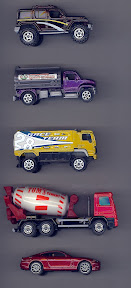
The solid, squat vehicle for off-road driving
The tanker for hauling a heavy, fluid weight a long distance
The large van for hauling heavy items a long distance
The concrete truck for hauling and mixing (and the best vehicle match I could find for ‘barrel’ ribs!)
The sports sedan for zipping along a smooth highway
That is why they are not squarish like the Springers and Irish who generally work over the vegetation and in more open country.
So what is the difference between the Field and Clumber and Sussex – the later two are more adapted to working in heavier vegetation on a day to day basis. The Field is the intermediary between the Springers and the Clumber & Sussex group – as body shape (breed type) can demonstrate.
So why aren’t Clumbers and Sussex the same – because the game population and the terrain are different.
CHANGE IS COMING
changes already adopted (but to be reviewed) by the English Kennel Club are listed here
http://www.thekennelclub.org.uk/item/2228
Any underlined text indicates a change or addition.
Square bracketed text indicates a deletion.
Spaniel (Clumber)
General Appearance [Delete ‘Well’] Balanced, well boned, active with a thoughtful expression, overall appearance denoting strength. Substance is important but without exaggeration as the Clumber should be firm, fit and capable of a day’s work in the field.
Head and Skull Large, square, [delete ‘massive’], medium length, broad on top with decided occiput; heavy brows; deep stop. [Delete – Heavy] Square muzzle with well developed flews. No exaggeration in head and skull.
Eyes Clean, dark amber. [delete ‘slightly sunk, some haw showing but without excess’]. Full light eyes highly undesirable. Free from obvious eye problems.
Forequarters Shoulders strong, sloping, muscular; legs short, straight, not too heavy in bone, strong.
Body Moderately long, well muscled, [delete ‘heavy, near to ground’]. Chest deep. Well sprung ribs. Back straight, broad, long. Muscular loin, well let down in flank.
Size Ideal weight: dogs: 29.5-34 kgs (65-75 lbs); bitches: 25-29.5 kgs (55-65 lbs).
Spaniel (Sussex)
General Appearance [Delete ‘Massive’] Strongly built. Active, energetic dog, whose characteristic movement is a decided roll, and unlike that of any other Spaniel.
Eyes Hazel colour, fairly large, not full, but soft expression and not showing [delete ‘much’] haw.
EXERCISE ONE – TERMINOLOGY
So, terminology, the choice of words, from any standard, may present challenges in its own right, as does working out (on the fly) from where the writer is when writing the description or that part of the description.
OK, I asked that everyone brought in five sheets of blank A4 paper and two pens/pencils — I guess some haven’t remembered, so NOW ask a neighbour if you can have one sheet and borrow their second pen. Get yourselves lined up somewhere so you can have the sheet of paper flat so you can write on it, I am going to ask you to write one word or symbol on your sheet of paper,
(and BTW there is no wrong answer to this – this is simply to show you how things can be interpreted by different people and still be right)
but so you can’t see what anyone close by you is writing I want you to place your pen tip near the centre of the sheet and hold the sheet with your non-writing hand so it the sheet won’t slip
everyone ready,
this isn’t a huge word, it will a second to write, but don’t dally as we have two breeds and hundreds of concepts to cover this evening
now close your eyes
now write “TWO” (que/cue/queue/Kew is another option)
just leave your pages lined up and spread out — see, I said TWO, or did I say TO or was that TOO, may be TUW, may be 2, possibly II —- there are a heck of a lot of ways to interpret a sound or a word; standards fall into this pliable usage regularly – it is just a dynamic in your learning, interpretation, and understanding. Now if we lined up all these ‘2’ entries in a class, how are you going to decide which are the best, and which is the winner? And how is this process going to become repeatable or closely repeatable by other folk so we can evolve the best and most fit ‘2’ for the purpose? By judging to a standard – so there is a need for standards, it lets breeders/developers hone the calibre of their exhibits to achieve the best performing individual.
Not convinced about the variety available within a standard, despite it being THE standard? How long is “LONG” how moderate is “MODERATE” two words that you will see time and time again in your studies and not once is either one measurable against a ruler or equal to 30 cm!
Stepping on, just in case you think I have forgotten this is a discussion about two great, and very important breeds!
DIMENSIONS AND CHANGE OF REFERENCE
Despite it being some time since I did my senior years of high school study and not warming to physics as a subject, one thing has really stuck in my mind – what the scientists call frames of reference. In life it means someone standing to the right will actually see something different to someone standing immediately in front of an object.
A passenger glancing over at the speedometer will see a higher speed than someone sitting directly in front of it. (But my nephew doesn’t believe me!)
Both KNOW what they are looking at and the mind will often ‘adjust’ and correct the image, but in truth that is not what the eyes see – an untrained eye will see something more truly, a ‘trained’ eye has the subtle and unconscious ability to correct a subject to conform to what we want to see, or expect to see. This is actually also an issue for someone outside the ring and ‘judging’ what the judge is judging, you are actually seeing dogs from different frames of reference, what you see from outside the ring is not what the judge will see, you may have the experience to make the necessary (inverted commas) ‘adjustments’ you may not.
This is the main reason I detest trainee judges ‘going over’ these breeds on tables, the breeds do not work or function on the table, so the trainee is only confusing himself by insisting on this examination height.
I guess it is because of the frames of reference issues that when we start to read a description we start from one angle, and sometimes forget or do not realize the description moves to a different plane, say from the side to the front. This is an off-topic example, the Chessie standard calls for “pasterns slightly bent”, I would say that meant viewed from the side but I heard an owner breeder one day categorically saying that the slope was viewed from the front as in Queen Anne (or whatever) legs. Considering the standard also says (in the same section) “Forelegs straight” I guess I am more right 🙂
My point here is that think, and be pliable with what you read – the standards are brief (and remarkably accurate) word pictures, but you cannot just sit or stand on the side of the dog to get the full picture; and you will need to take and compare sentences or descriptions from two or more sections to get a full picture in your mind.
I know a Clumber has a thick coat, laid nicely but can be easily lifted, with feathering from the chin down the chest and between the front legs and fading as it reaches the groin, feathering on the back of the front legs and on the breeches and also on the tall with feet nicely clothed too, I know this because the standard tells me so, but not simply in one section.
The Clumber has
“Abundant, close, silky and straight. Legs and chest well feathered. ” listed under coat, and
“well feathered,” listed under tail, and “well covered with hair” listed under feet
if you don’t read the whole standard (and this one is some 270 words only) you won’t get the whole picture
You need to read and apply the WHOLE standard to get a good picture of a correct type of dog.
GAIT
Now let’s get into these two breeds.
And having been to a number of lectures over the years I know the end of the standards are often overlooked for a want of time – that is silly, so let’s start at (or near) the end, with the descriptions for gait.
What is gait? Gait – is movement
What is rolling? What word would you use to describe the gait of any of these items?

“Rolling gait attributable to long body and short legs. Moving straight fore and aft, with effortless drive. ”
is from which standard? …………
Clumber
“True fore and aft with distinctive roll.”
is from which standard? …………
Sussex
but bear in mind the General Appearance also says “Active, energetic dog, whose characteristic movement is a decided roll, and unlike that of any other Spaniel.”
Now as a judge you are standing fairly much in the centre of the ring, you look up and across at the dogs as the steward passes the class to your control, unless the dogs can pop up like the old cash register display numbers, you are going to see the dog’s move, to move they display their gait to you.
“true” from my favourite book of terminology, the Oxford dictionary, and as it is not in the ANKC Glossary of Terms, is “in accordance with fact” or more precisely in our field of study (dogs and conformation) as for wheels (ie movement!) “in correct position” or of tooling (so the ability to work properly)and let me paraphrase “not wobbling, not likely to slip or allow wear due to bad alignment, working well” – like well made clockwork mechanism (despite all those various sized and shaped wheels etc) AND keeping good time
“true” is staying on course, to tell the truth presents the facts – “this is a white shape”, to tell a lie (not be true) is to go off course and add extra unnecessary things “this is a black circle”
“true” is achieved through good joint construction with nicely toned and developed bones, muscles, and ligaments working freely and without a jerky movement to give a fluid and free movement in the best direction to achieve movement of the dog without causing excess damage to the living joint surface or any bone, ligament, or muscle.
“true” is clean and efficient movement without flailing or flamboyant action (which uses more energy) which places the limbs, feet, toes, etc outside the natural protective range of the body
“true” sees an optimum length stride that covers a reasonable amount of ground without over exertion on the muscles and energy supply and without stressing or over-flexing the joints involved
a “true” action will allow the dog to cover ground efficiently without unnecessary exertion so the dog can continue that pace for hours or easily adapt to a more difficult terrain.
“true” from the side view (where some judges tend to place a heavy weight in their assessment of gait) is a clean stride, that does not have the hind limbs over reach the forelimbs ground strike, that has the forelimbs lift cleanly but without excess, what is the point of a high stepping spaniel? A high stepping spaniel is time and energy expended for no forward action. AND it leaves the forelimbs prone to tangle with the vegetation he is hunting in.
“true” from the front, and “true” from the rear is the limb apparently not ‘breaking in the middle – the wrist or the hock or stifle and flicking in or out – again if this happens the limb is at peril of being caught or snared on the vegetation. A dog with a sore limb will tire quickly, he will not be as flexible or mobile, he will not be an asset to the hunter, and he may require veterinary consults!
BUT the limb must flex correctly at these joints to offer good value, the hip, stifle, hock and the foot joints must all flex reasonably and within the usable range on the front/back plane – they must not be sloppy or malformed to allow any considerable movement to the out or inside (left/right) of the limb, they will allow this for turning, but on forward movement the ligaments, muscle tone and well formed bone heads/end on the joints favour forward and back action.
AND “true” refers to each and every operational joint in each of the limb systems, no where does the standard allow for an untrue joint – so don’t tolerate a weak stifle or defective hip – the weakest part of any chain is the weakest link – the limbs are a chain and the joints are links in the chain
Stepping away from the standard – in fact not being “true” to the standard – grin – do either of these breeds truly centre track?
NO
for the reason they have decent rib cages with spring (so their limbs are set more to the side of the body then under it) AND they have reasonably short legs; it would not be physically possible to use the single centre track unless there was a huge merry-go-round up and down movement AND body twist, through an articulation point behind the withers, to allow the legs on each side to hit that centre track (all of which may be appropriate to a Thelwell Shetland Pony but it has no place in the field working dog)
BUT the limbs tend to diverge to the centre track
BUT, I heard a thought bounce off someone, isn’t that the roll the standards talk of?
Turning back to the dictionaries and glossaries, the ANKC Glossary of Canine Terms (1996)
NO the roll is not a side to side reeling, these are dogs in the field, not lightly bouyed ships in a heavy swell or drunken sailors – what earthly use to a spaniel that works in undergrowth is a side to side roll? His sides and skin and hair would be prone to catching on vegetation if he rolled from side to side — a train hurtling through a narrow tunnel doesn’t roll side to side (it would break apart as it hit the walls), but the train does roll forwards.
The ANKC Glossary of Terms (3rd Rev) says “Rolling gait : Rolling action. The pelvic region moves slightly from side to side, seen when the dog is moving away” – which, except for degree, is physically essential for EVERY breed of dog as a hindleg is driven/pulled forwarded by the muscles so the hip drops (and the support of the leg is removed), the hip is attached (most often except in really severe HD) to the pelvis, the pelvis drops. Why then is a rolling gait noted in the Sussex and Clumber – and are the rolling gaits of the two breeds the same – YES or NO?
the rolling gaits of the two breeds are not the same
because remember the start of the the Sussex standard reads “… whose characteristic movement is a decided roll, and unlike that of any other Spaniel.”;
why is it different?
BECAUSE of the “free shoulder”. I had been mulling over this a few days and watching a film when an Asian elephant lopped across the screen, ‘there’s a free shoulder’ so it is, because now look at the ox and now the goat, and here’s the elephant again. So after a bit of Googling and I see African elephants (despite their whacking great ears getting in the line of view) aren’t quite as free for the length of the shoulder blade but you can still see visible movement of the blade as the animal walks.
http://revver.com/video/88901/elephants-walk/ is the best video I could find on line to demonstrate the free shoulder action on an elephant.
The shoulder blade actually pivots back and forward rather like a metronome, in the Asian elephant, whereas it is more common for it to be fairly stable in other mammals.
The free shoulder contributes significantly to the roll of the Sussex, his short legs stop him from a side to side roll as he is not a high stepping (flamenco) mover.
The free shoulder, the bulk of the dog for his height, the width of the dog, the rounded (but not barrel) ribs allow him to traverse through thick undergrowth at a decent speed without being caught up or suffering tears.
You can tell so much about the overall type of the dog from the gait.
The gait is the product of the dog’s type (and a little bit of his physical condition).
The Sussex roll and free shoulder appeared in the standard in the 1920s.
The Clumber’s roll is attributed to a “long body and short legs” BUT in the same section it is qualified with “Moving straight fore and aft, with effortless drive.”
Again for a spaniel to ricochet off and onto vegetation jeopardizes his health and longevity – it is of NO use to a spaniel that is expected to get into the scrub, get the game out, and to come back out to work more scrub.
The body is long, but if there is decent angulation then the withers are set back over the body, so the point of shoulder (the connection between the shoulder blade and upper arm) is still over the rib cage (so it helps protect the rib cage and the muscles have somewhere to attach) the back may appear short — bear this in mind, the roll is attributable to the LONG BODY not a long back, and the short legs are set (viewed from the side) fairly well under the dog — combine this with the information that the dog moves true and with effortless drive, you cannot expect (and as I pointed out) you do not want to see a reeling from side to side when viewed from behind or in front. The Clumbers’ roll is a forward momentum – and will in a correct skin and coat cause the SKIN to appear to slide or ‘roll’ from the pelvis across the back and over and down the opposite shoulder — a great asset for a taller but heavy spaniel that has to get into heavy undergrowth and pass rapidly under fallen or drooping tree limbs, his skin and coat in effect act as a lubricant should he catch on some vegetation or rock, he can continue most often at an uninterrupted pace and just glide off snares and without damaging himself.
From the gaiting you can assess “gait”, for a Clumber is there
“effortless drive”
“Straight fore and aft movement”
“that special Clumber roll”?
for the Sussex is there
“a unique Sussex roll clearly (distinctively) showing”
“is the dog moving true fore and aft”
From gaiting you can assess (or start to assess) a heap of other things too – for to move a dog must have limbs and limbs are attached to the body, and the size and proportion of those limbs and the size and proportion of the body, and where those limbs sit naturally in relation to the body will have a huge influence on the actual gait demonstrated.
The position of the legs in relation to the body, the length of the leg, the angulation of the limbs , and the length of the neck (so the counterweight effect of the head), and the width of the body, and muscle mass of the hindquarter are the things I see as having the most impact on the gait of a dog, and also on the ‘type’ of the dog.
I have discussed and shown you gait for these two breeds and how that gait gives the dog the ability to do its specialized job, and I have also touched on how the body shape makes that gait even more effective; but let’s have a look at angulation.
ANGULATION
Angulation (for me) is the lay or the angle a joint creates, how one limb bone relates to another, and how the end of the limb relates to the actual body or spine.
the important angles are
- between the neck and shoulder (the lay of the shoulder – required in both standards)
- between the bottom end of the shoulder and the top end of the upper arm (not detailed in the standard)
- between the lower end of the upper arm and the top of the lower leg (the arm)
- between the lower end of the arm and the foot as demonstrated/perpetuated by the pastern
- and in fact, also the angle or lay of the toes (which is implied but not explicitly listed)
- on the hind end
- the pelvis in relation to the topline/back
- the upper thigh to the pelvis (at the hip)
- between the upper thigh and the lower/second thigh (at the stifle) – detailed on the standards
- at the lower end of the second thigh and the top end of the rear leg – the actual hock joint
- and again the actual toes
I discovered not long ago, many people consider only the middle joints in angulation –
but there are joints at all these places for a reason and that is a functional reason.
Disregard the strength and reliability of any one or more of these joints and you imperil the health and longevity of any breed.
Exhibitors will chance a judge not being demanding, don’t reward their assumption, if you do, they will dare to let their standards drop as breeders and the slow rot of a breed will set in and you will have the honour of judging less sound dogs each generation.
Angulation for the Clumber is marked and well defined, it is less marked but it is still required in the Sussex
Why? the Clumber is a taller set dog, he must be able to go over fallen trees, so needs a bit more length of leg, he must be able to jump up onto banks, and clamber over logs – but to have long legs is to offer more chance of leg breakage in such terrain – to have really short legs he is so low set to the ground he has no clearance or leverage to utilize – the compromise is the shortish leg WITH GOOD angulation – the angulation (if muscled) will allow him to drop his body down (get under things) but also unfurl himself and give himself more ground clearance.
A Sussex is ideal for working less cluttered ground and wide open rolling plains, to have more angulation is wasted. But he needs good moderate angulation to give him ground covering strides, there may be good game supplies in Sussex but there are only 24 hours in a day!
BODY SHAPES
The Sussex has a rounded rib cage, and a fairly long body – long in that the forelimbs are set more forward then you can tolerate in a Clumber. The gait and this shape, and his roll, allows the short set dog (16 inches) to literally walk through light growth that may even be over his head height – the body shape protects and carries his organs, and his limb position both protects and supports the ribcage but also the ribcage and neck shape protects a well structured limb – there are no bits sticking out and getting caught.
The Clumber is slightly taller – a rounded rib cage would make him too wide set to walk though fallen branches without getting sticks jammed up into his chest or belly, the ribs are well sprung but it is not a round ribcage. Again, the moulding of a good Clumber sees the limbs support and protect the ribcage and at the same time the ribcage and neck shape protect the limbs.
STORM WATER PIPE, ONE DISTORTED TO SHOW CLUMBER RIB SPRING, THE OTHER CYLINDRICAL TO SHOW SUSSEX RIB SPRING
NECKS
A persistent fault in dogs is an incorrect neck length. A short neck places more weight directly over the forelimbs (so adding weight to upper surface areas of the joint ends/surfaces), it does not allow mobility of head for inspecting terrain, it does not allow a dog to comfortably scent/track nor to carry weighty game. It in fact changes the type of the whole dog.
A Clumber has “Fairly long, thick, powerful.” – unequivocally NOT short, reward a short necked Clumber you are awarding a bad type of dog, same too for a Sussex;
A Sussex has a “Long, strong, and slightly arched,” neck – look, long – unequivocally
LONG relates to the dog not the species or other animals, giraffes have long necks, and certainly the giraffe neck is derided in the Sussex standard (head carried just above the topline), and the standard calls for moderation for the Clumber to “fairly long”
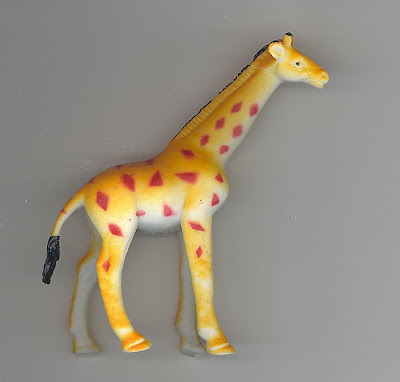
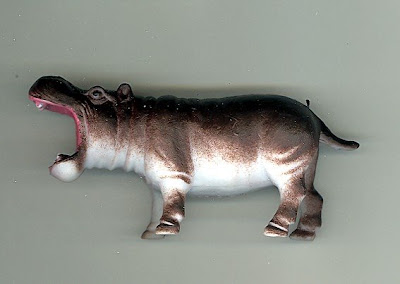
The necks must be strong, both breeds have decent sized heads that are carried near to the ground for long periods in scenting – watch a giraffe with a long and fine neck do that.
Length of neck is dictated by the number of vertebrae (but I have feeling all mammals only have 7 nexk vertebrae) — AND the position of the shoulder blade, an upright shoulder will give you a shorter neck (and a thicker shoulder).
HEAD AND EXPRESSION
As with many, many breeds, the head and expression is breed specific – same for the Sussex and Clumber breeds.
In direct comparison with each other the Sussex has a softer, less square head than the Clumber – but the Clumber head is not a short head either (standard “medium length”) he gets his ‘big’ head from the brows, depth of stop and depth of the flew (Standard “heavy brows; deep stop. Heavy, square muzzle with well developed flews”)
The Sussex has a more typical spaniel head type “pronounced stop. Brows frowning; occiput decided, but not pointed. ”
The expressions are miles apart, and a product of their actual head shapes (but are a fair indication of each breeds’ actual temperament for that matter)
The Sussex with good breed type has a distinctive “frown” on just about all occasions – the brows are knitted, he is querying your sincerity not scowling at you. The brows are noticeably larger towards his nose, and rise over the eyes.
The Clumber has a thoughtful expression – the top eye lid is not typically curved but usually in a straight line (“heavy brows”) the brows do not obstruct the vision of a good dog but you still get that far away ‘brown study’ or thoughtful look – a Clumber mulls over your apparent intentions and he won’t swing his thoughts back and look you in the eye unless you are HIS person.
Speak to me of the two breeds and I can tell if you know them by your choice of words when talking about expression – a Clumber never frowns, a Sussex is much quicker off the mark than to be caught thinking on a subject.
THE DOGS
A dog is the product of the conformation (bones/ligaments/muscle) and his condition (muscle tone). You can have a dog with good type but if there is no tone or correct bulk of muscle he cannot stand, if he cannot stand, he cannot move, if he cannot move he cannot work. And there is no value in a dog that can just get around the show ring but ends up puffing and drooling on a couple of circuits on nice flat ground.
Both breeds MUST HAVE decent hindquarter muscles – it says so in the standards, so don’t reward dogs that fail in these departments, to do so ignores the breed standard. To do so rewards dogs not fit to represent their breeds, and for that matter their breeders.
Sussex “Thighs strongly boned and muscular;” muscle – that’s the firm large bulky mass on the outside of the bone – you find it on three sides of the bone, it fills the cup of your hand.
Clumber “Very powerful and well developed.” that just says MUSCLE of good tone and volume
Good tone and volume of muscle is required THROUGHOUT each of the breeds,
- it gives strength,
- it holds the parts together in a less than typical wolf form,
- it gives bulk in a short dog,
it gives substance to the dog – that coupled with the form (body shape, limb length and placement, neck length, head type and carriage, the particular gaits these give, the pliable but tough skin, the abundant coat) and decent and healthy muscle tone and mass adds a bit more clout and makes both of these breeds better able to complete their ancestral tasks without burning energy, demanding excess food intake, longer toilet breaks, or visits to vets!
Fat is no compromise – live fat is like jelly – it slops like jelly and it holds few nutrients like jelly.
Muscle is firm and has the attachments and power to actually flex and straighten joints and to store great amounts energy for these things to happen.
Fat is not tone or condition – it is the sign of bad management.
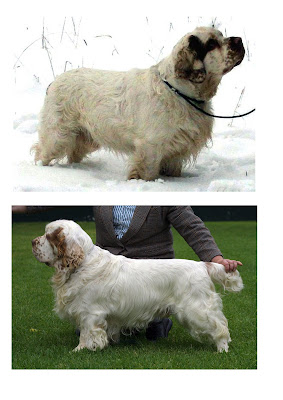

adult males
Sussex photos courtesy http://www.sussexspanielsociety.com/
THE ICING
What’s the packaging that puts the dog together and makes him a functional animal?
His colour? Or his skin and coat?
Skin and coat are the icing, colour is the decoration it doesn’t stop him from doing his job (in most cases)
The skin is not discussed in the breed standards – however, knowing the Clumber, I can tell you there are hints in the standard, the Clumber skin is relatively loosely attached – it is not detached, it is relatively thick and pliable – assets for working in brush, undergrowth, under fallen trees, and shaking off water. On observation, the Sussex skin is fairly thick but a more snug fit – the Sussex was not developed where the vegetation was quite as demanding, he was not expected to stay and work within the vegetation for as many hours, and the tracts of heavy vegetation are not as extensive.
The coat is discussed – the coat should form part of your assessment, it is not to be ignored.
Sussex “Abundant and flat with no tendency to curl and ample undercoat for weather resistance.” – with moderate feathering – but the butt of the tail is clothed not feathered/fringed
Clumber “Abundant, close, silky and straight.” well feathered on legs, chest, and tail
Abundant means you cannot tolerate a dog that has been clipped or stripped
The Clumber has a silky coat – and is often cold to touch – the dirt DOES actually come off when it dries
Abundant refers to the body coat – not the feathering, feathering is moderate on a Sussex, always, so moderate that the butt of the tail is clothed not feathered; the feathering on the Clumber is longer (but never with excess) due to the silky nature of the coat.
THE DECORATIONS
Colour – again the standards discuss this, and they are distinctive to each breed, and are of some value for that matter – they are not just bling.
The Sussex is a GOLDEN LIVER – it is not a colour found in any other spaniel – a softish liver with a golden hue and in the older dog the longer trimmings have a golden halo. The golden liver is dark enough to be distinguishable by the hunter in autumn harvest fields but discreet enough to act as camoflauge for most game.
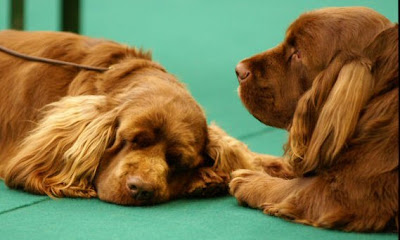
courtesy Sussex Spaniel Society (sussexspanielsociety.com)
The Clumber is a shimmering white; there are various shades of white, but white it is – not yellow, and not bleached stark white. The Clumber has markings, markings have always been considered bling, they are not sought or endorsed but will occur – IF the marking does not ‘kill’ the white dog effect, the marking is not too big. The dog is white so flashes of him can be seen in the heavy undergrowth. The colour of the markings is a genetic series of dilution – the real Clumber is LEMON, but there are more and more without the dilution factor and so more and more with darker markings. I don’t believe the colour of the markings affects the dog’s ability to work or to love, and it rarely has anyone thought that a heavily marked dog is anything other than a Clumber, a Clumber is more than the depth of the colour of his markings. (Personally I believe in and strive for the yellow lemon)
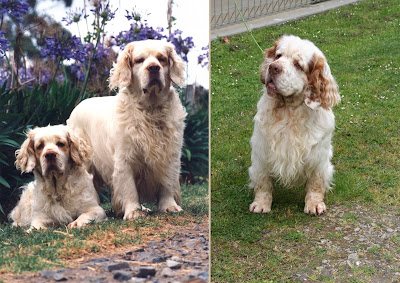
RESOURCES
changes already adopted (but to be reviewed) by the English Kennel Club are listed here
http://www.thekennelclub.org.uk/item/2228
books – the VCA Library have the major Clumber and Sussex titles available
Edward J Orton A HISTORY OF THE SUSSEX SPANIEL UK 1987
Peggy Grayson THE SUSSEX SPANIEL UK 1989
Peggy Grayson and Rae Furness THE CLUMBER SPANIEL UK 1991
Jan E Irving CLUMBER SPANIELS USA 1998
Jan E Irving THE WHITE SPANIEL Australia 2000 (not for loan)
previous breed lectures available online
Clumber Spaniel League Victoria – Learn More About Clumbers https://www.erinrac.com/cslv/contents.php?sectionid=47
Erinveine Clumbers – Breed Lectures and Information on Type etc https://www.erinrac.com/category/erinveine/aboutclumberspaniels/clumber-lectures-breed-type/
Kate Keely’s Powerpoint presentation – this is nearly 5MB so a large file https://www.erinrac.com/erinveinx/information/sussex/TheSussexSpaniel.ppt
Kate Keely’s Breed Lecture 2001 https://www.erinrac.com/erinveinx/information/sussex/TheSussexSpaniel.pdf
breed standard extensions, etc
Clumber
ANKC – http://ankc.org.au/_uploads/docs/23635Clumber_Spaniel_BSE.pdf
USA – http://clumbers.org/sourcedocs/illustrated_standard.pdf
Sussex
ANKC – have not adopted one
USA – have not adopted one – but beware of using USA material as the standard requires a completely different type of dog
standards as on the ANKC website 29 April 2009
| standards as on the ANKC website 29 April 2009 | Sussex Spaniel | Clumber Spaniel |
| General Appearance: | Massive, strongly built. Active, energetic dog, whose characteristic movement is a decided roll, and unlike that of any other Spaniel. | Well balanced, heavily boned, active with a thoughtful expression, overall appearance denoting strength. |
| Characteristics: | Natural working ability, gives tongue at work in thick cover. | Stoical, great hearted, highly intelligent with a determined attitude enhancing his natural ability. A silent worker with an excellent nose. |
| Temperament: | Kindly disposition, aggression highly undesirable. | Steady, reliable kind and dignified; more aloof than other Spaniels, showing no tendency towards aggression. |
| Head And Skull: | Skull wide, showing moderate curve from ear to ear, neither flat nor apple headed, with centre indentation and a pronounced stop. Brows frowning; occiput decided, but not pointed. Nostrils well developed and liver in colour. Well balanced head. | Square, massive medium length, broad on top with decided occiput; heavy brows; deep stop. Heavy, square muzzle with well developed flews. No exaggeration in head and skull. |
| Eyes: | Hazel colour, fairly large, not full, but soft expression and not showing much haw. | Clean, dark amber, slightly sunk, some haw showing without excess. Full light eyes highly undesirable. Free from entropion. |
| Ears: | Thick, fairly large and lobular, set moderately low, just above eye level. Lying close to skull. | Large, vine leaf shaped, well covered with straight hair. Hanging slightly forward, feather not to extend below leather. |
| Mouth: | Jaws strong, with a perfect, regular and complete scissor bite, i.e. Upper teeth closely overlapping lower teeth and set square to the jaws. | Jaws strong, with a perfect, regular and complete scissor bite, i.e. Upper teeth closely overlapping lower teeth and set square to the jaws. |
| Neck: | Long, strong, and slightly arched, not carrying head much above level of back. Slight throatiness, but well marked frill. | Fairly long, thick, powerful. |
| Forequarters: | Shoulders sloping and free; arms well boned and muscular. Knees large and strong, pastern short and well boned. Legs rather short and strong. | Shoulders strong, sloping, muscular, legs short, straight, well boned, strong. |
| Body: | Chest deep and well developed; not too round and wide. Back and loin well developed and muscular in both width and depth. The back ribs must be deep. Whole body strong and level with no sign of waistlines from withers to hips. | Long, heavy, near to ground. Chest deep. Well sprung ribs. Back straight, broad, long. Muscular loin, well let down in flank. |
| Hindquarters: | Thighs strongly boned and muscular; hocks large and strong, legs short and strong with good bone. Hindlegs not appearing shorter than forelegs or over angulated. | Very powerful and well developed. Hocks low, stifles well bent and set straight. |
| Feet: | Round, well padded, well feathered between toes. | Large, round, well covered with hair. |
| Tail: | Set low and never carried above level of back. Lively actioned. Preferably docked to a length of from 13-18 cms (5-7 ins) | Set low, well feathered, carried level with back. |
| Gait/Movement: | True fore and aft with distinctive roll. | Rolling gait attributable to long body and short legs. Moving straight fore and aft, with effortless drive. |
| Coat: | Abundant and flat with no tendency to curl and ample undercoat for weather resistance. Ears covered with soft, wavy hair, but not too profuse. Forequarters and hindquarters moderately well feathered. Tail thickly clothed with hair but not feathered. | Abundant, close, silky and straight. Legs and chest well feathered. |
| Colour: | rich golden liver and hair shading to golden at tip; gold predominating. Dark liver or puce undesirable. | Plain white body preferred, with lemon markings; orange permissible. Slight head markings and freckled muzzle. |
| Sizes: | Ideal Height: 38-41 cms (15-16 ins) at withers Ideal Weight approx. 50 lbs |
Ideal Weight: Dogs 36 kgs (80 lbs) Bitches 29.5 kgs (65 lbs) |
| Faults: | Any departure from the foregoing points should be considered a fault and the seriousness with which the fault should be regarded should be in exact proportion to its degree and its effect upon the health and welfare of the dog. | Any departure from the foregoing points should be considered a fault and the seriousness with which the fault should be regarded should be in exact proportion to its degree and its effect upon the health and welfare of the dog. |
| Notes: | Male animals should have two apparently normal testicles fully descended into the scrotum. | Male animals should have two apparently normal testicles fully descended into the scrotum. |
